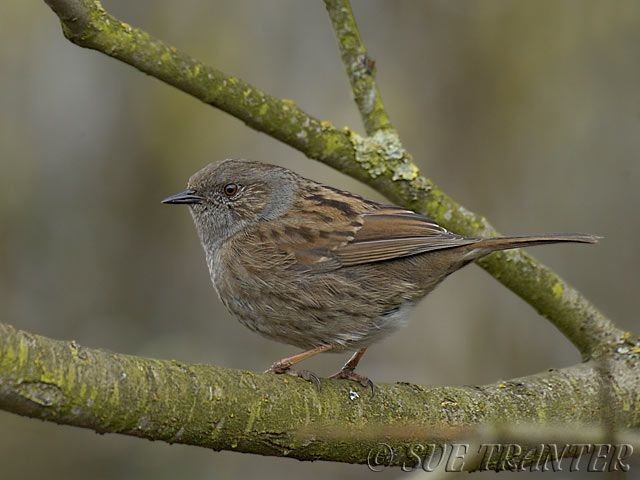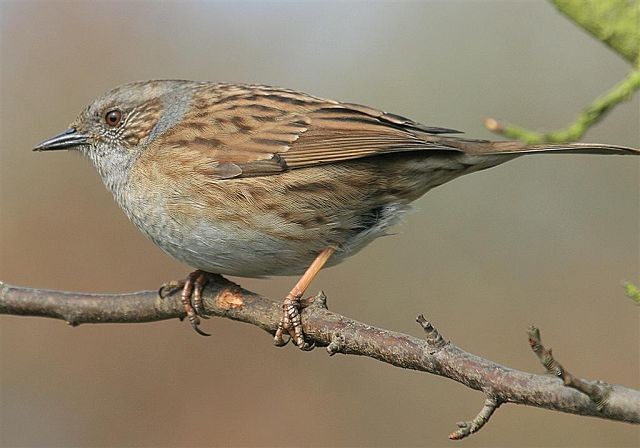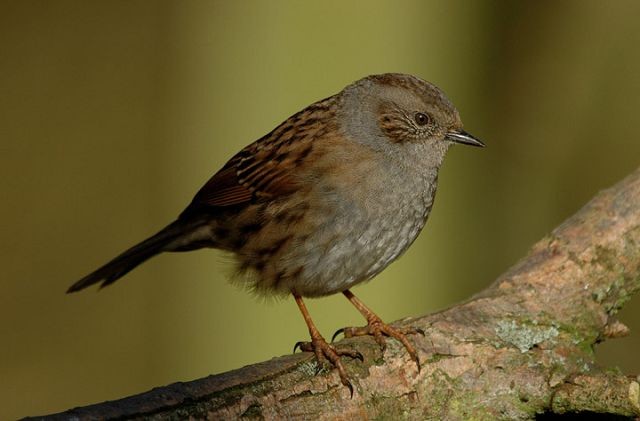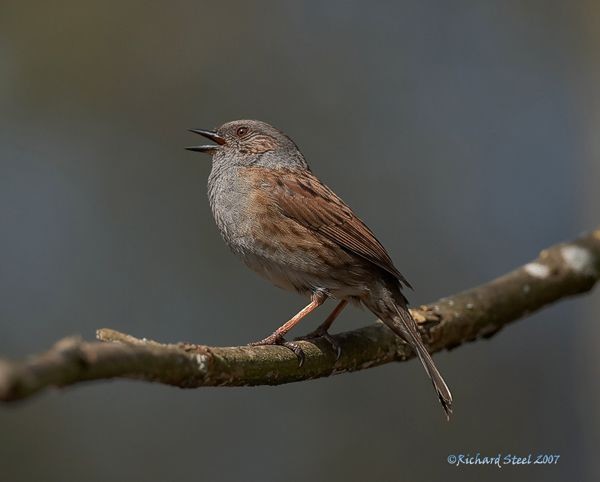
Dunnock (photo: Sue Tranter)
The Dunnock is one of those birds that can easily go unnoticed within the garden. About the size of a Robin, but slimmer in build, this small, rather plain-looking, bird tends to forage on the ground beneath bushes and shrubs. Yet its unobtrusive nature and drab plumage hide an extremely charismatic and engaging bird, whose social behaviour and living habits are nothing if not rather unusual.
Perhaps the most striking aspect of Dunnock behaviour is its complex social system. While many Dunnocks adopt a monogamous relationship with a would-be partner, others engage in more complicated arrangements. It is quite common for one female to engage in a relationship with two males (something that is given the rather grand title of 'polyandry'). Somewhat less commonly, a single male may establish bonds with two or more females (known as 'polygyny') and there are even cases of groups of two or three males consorting with three or four females ('polygynandry')! These rather unusual groupings seem to occur because male and female Dunnocks maintain their own, largely independent, territories during the breeding season. Since male territories are larger than those of the females, you might expect a single male to have access to more than one female, giving rise to polygyny. However, what makes the social complexities all the more interesting is that some male territories are shared by two males. One of the two males (termed the 'alpha' male) will be dominant over the other (the 'beta' male). The beta male manages to secure his position within the territory of the alpha male through sheer persistence, something which provides him with a degree of access to any females. However, access is not guaranteed, since the alpha male spends a great deal of time guarding his female, especially as she approaches the egg-laying period.

Dunnock (photo: Tom Melton)
A series of pre-copulation displays have evolved alongside this bizarre social system and these displays are geared towards attempts on the part of the male to guarantee his parentage of any offspring resulting from the union. Immediately prior to copulation, a female Dunnock will crouch low in front of her prospective mate, fluff up her body feathers, raise her tail and quiver. The male, positioned behind the female, will then hop from side to side before pecking at the female's vent (also known as the cloaca). The male's pecking of the cloaca may continue for several minutes and, over this period, it may become pink and swollen. As it swells, it makes strong pumping movements and these result in the ejection of sperm from previous mating attempts. In this way, a male can increase his chances of fathering any young resulting from the union.
Another frequently observed display occurs where two or more males come together to dispute a territory. Such interactions involve bouts of wing-flicking and chasing, and it is interesting to note that beta males work with their alpha male to defend the 'shared' territory from would-be intruders. Both males will also indulge in song to advertise their ownership of the territory. This might suggest that there is a benefit for an alpha male in having a beta male within his territory. However, any benefits that come from having another male to help with territorial defence are balanced by the disadvantages of having a male sharing your territory who is looking for any opportunity to mate with your partner. This is why the alpha males invest so much time in guarding their females (as much as 40 minutes an hour).
Now, all this may seem a bit harsh on the poor female, constantly followed by one male, with another looking to take advantage of her given sufficient opportunity. However, the female is also seeking to maximise her advantages from this social system and she does this by actively soliciting mating attempts from the beta male. Sometimes the female will shake off her alpha male so that she can elope with the beta male for a brief liaison. She does this because a male will only help to rear her chicks if he has been able to secure several matings with her. By encouraging both males to mate with her, the female should secure both of their services when the eggs hatch.
The Dunnock is also interesting because it is one of the main hosts for the Cuckoo, a species renowned for laying its eggs in the nests of other species - a behaviour known as brood parasitism. A female Cuckoo, visiting the nest of a Dunnock, will remove one of the Dunnock's eggs before laying one of her own directly into the nest. Individual female Cuckoos specialise on one particular host, usually Dunnock, Robin, Meadow Pipit, Reed Warbler or Pied Wagtail. The eggs of the different host species vary in colour and pattern and, since an unusual-looking egg is likely to be rejected by the host, there is a selection pressure on the female Cuckoo to produce eggs that closely resemble those of the host. This is why individual female Cuckoos tend to specialise on one particular host.

Dunnock (photo: John Dickenson)
Cuckoos that parasitise species like Reed Warbler and Meadow Pipit produce eggs that closely match those of their host. However, in the case of the Dunnock, the Cuckoo eggs look very different from the blue eggs produced by the Dunnock and you might expect them to be rejected by the parent birds. Interestingly, Dunnocks rarely reject Cuckoo eggs and this suggests that they are not particularly discerning parents. Since it is in the Dunnock's interest to spot the Cuckoo egg, it seems likely that the Dunnock is a relatively recent host and has not yet shown an evolutionary response to this act of nest parasitism. Because the level of nest parasitism is low within the Dunnock population as a whole, it may be some time before an evolutionary response becomes apparent.
Once the young Cuckoo has hatched from its egg it will set about removing any other eggs or young Dunnocks that remain in the nest. In this way the Cuckoo chick is able to secure all the attention of its adopted parents, quickly growing in size on the food provided. It may seem surprising that adult Dunnocks continue to feed the Cuckoo chick even though it will eventually come to dwarf them in size. However, the urge to feed any begging mouth may be so strong that the parents will feed the interloper even though it looks very different from a chick of their own species. Experiments, carried out by researchers studying animal behaviour, have discovered that Dunnocks (and virtually all other Cuckoo hosts) won't discriminate between Cuckoo chicks and their own chicks, even if the two are paired together in the same nest. Ending up with a Cuckoo in your nest may seem disastrous but, since a pair of Dunnocks can rear two or even three broods in a season, they could still have the opportunity to rear chicks of their own later in the year.

The use of gardens by Dunnocks shows a pronounced seasonal pattern, as revealed by BTO/CJ Garden BirdWatchers
Outside of the breeding season, Dunnock social behaviour is rather less complicated. During the winter months, many Dunnocks will lead a largely solitary existence, only coming together to feed in small groups if a feeding opportunity is particularly rich or food is hard to come by elsewhere. As with other small birds, overwinter mortality can be high if conditions are unfavourable, either because of starvation or because individuals take more risks to get at food and so leave themselves open to predation by cats or Sparrowhawks. There may be competition for food and as you might expect it is the dominant individuals, like adult males, which are able to gain first access to food.
During periods of cold weather, therefore, it is often worth putting out food for Dunnocks, placing small seeds, grated cheese and bread crumbs under the shelter of bushes and other garden plants. The fine bill is ideally suited for dealing with smaller items of food and it is also a useful feature to look for if you are unsure about separating your Dunnocks from your sparrows. While Dunnocks use their fine bills to tackle small seeds, sparrows will use their heavier bills to deal with grain and other large seeds.
Over the last few years we have received increasing numbers of reports of Dunnocks feeding from tables and hanging seed feeders. This suggests a general change in feeding behaviour, perhaps following the introduction of more diverse seed mixes. Even so, Dunnocks appear rather timid around feeding stations, preferring to make brief sorties rather than linger for longer bouts of feeding. Watch your visiting Dunnocks and you are likely to discover that they are a long way down the pecking order, unable to hold their own against most other species. Robins seem to give Dunnocks a particularly hard time. As regular readers will know, Robins are surprisingly aggressive birds (see Bird Table 43). This aggression sometimes spills over to be directed towards unfortunate Dunnocks. Perhaps it is the Robin-like shape of the Dunnock that stimulates an attack or perhaps Robins view Dunnocks as genuine competitors. Either way, it is easy to see why the Dunnock is one of the more secretive of your garden visitors.
While the Dunnocks in your garden are likely to be local birds, born within a few kilometres, Dunnocks from northern parts of Europe undertake annual migrations and can move significant distances. Some of these birds may pass through Britain but are likely to go unnoticed; apart, that is, from on islands like Fair Isle (off the Scottish north coast) where the species does not usually breed.
The Dunnock has been placed on the Amber List of birds of conservation concern because its breeding population underwent a substantial decline between the mid-1970s and the mid-1980s. Since then the population has recovered somewhat, although numbers have not returned to previous levels. While you may view the Dunnock as being rather unremarkable it is actually far from it. With an unusual breeding system, the unwelcome attentions of the Cuckoo and flagged as being of conservation concern the Dunnock is actually rather special. Next time you see one in your garden, just bear this in mind.

Dunnock (photo: Richard Steel)
About BTO/CJ Garden BirdWatch
This article first appeared in Bird Table, the magazine of Garden BirdWatch, which is the largest year-round study of garden birds anywhere in the world. The 16,000 participants have already helped to highlight the increasing use made of gardens by species like Long-tailed Tit, Goldfinch and Woodpigeon. Their observations have also helped researchers to understand the reasons behind declines of House Sparrow, Starling and Song Thrush, and they have alerted us to sudden changes in status that are of conservation concern.
Garden BirdWatch is all about getting involved and gathering useful information, by using simple recording techniques. All you need to do is to keep a record of the birds seen using your garden during the course of the week. You can note the birds that you see over your morning cup of coffee or while working in the garden. How much time you spend recording is up to you. All that we ask is that you try to be consistent from one week to the next. The information you collect can then either be posted back to us once every three months or you can enter your observations online.
Garden BirdWatch is unique among BTO projects in that it is self-funded, thanks to the generosity of its participants, each of whom pays an annual contribution of £12.00 to cover the costs of producing the survey forms, the quarterly magazine Bird Table, analysing the results and running the survey. Please help us by giving your support today. For a free information pack, please email gbw@bto.org or call 01842 50050.


